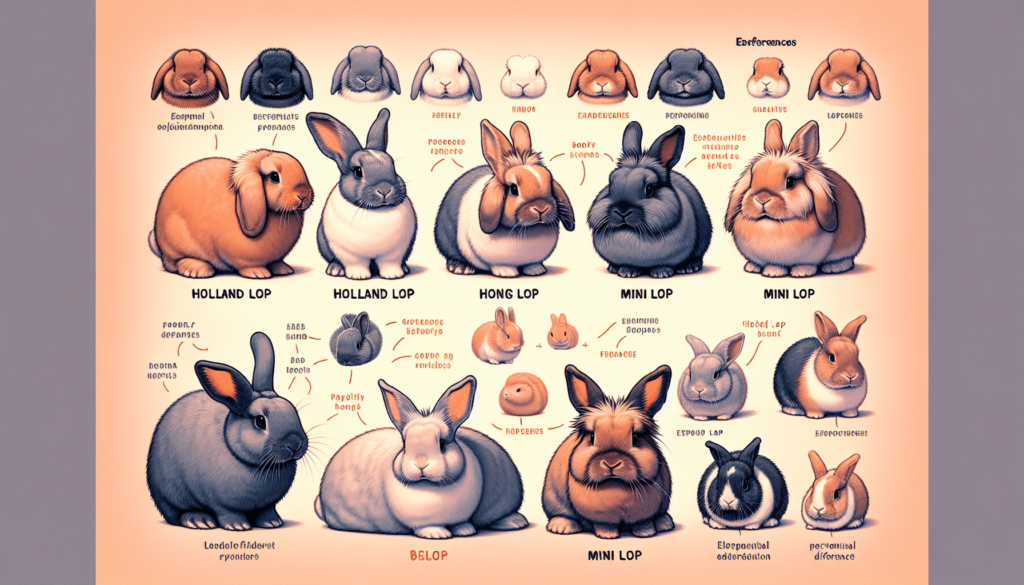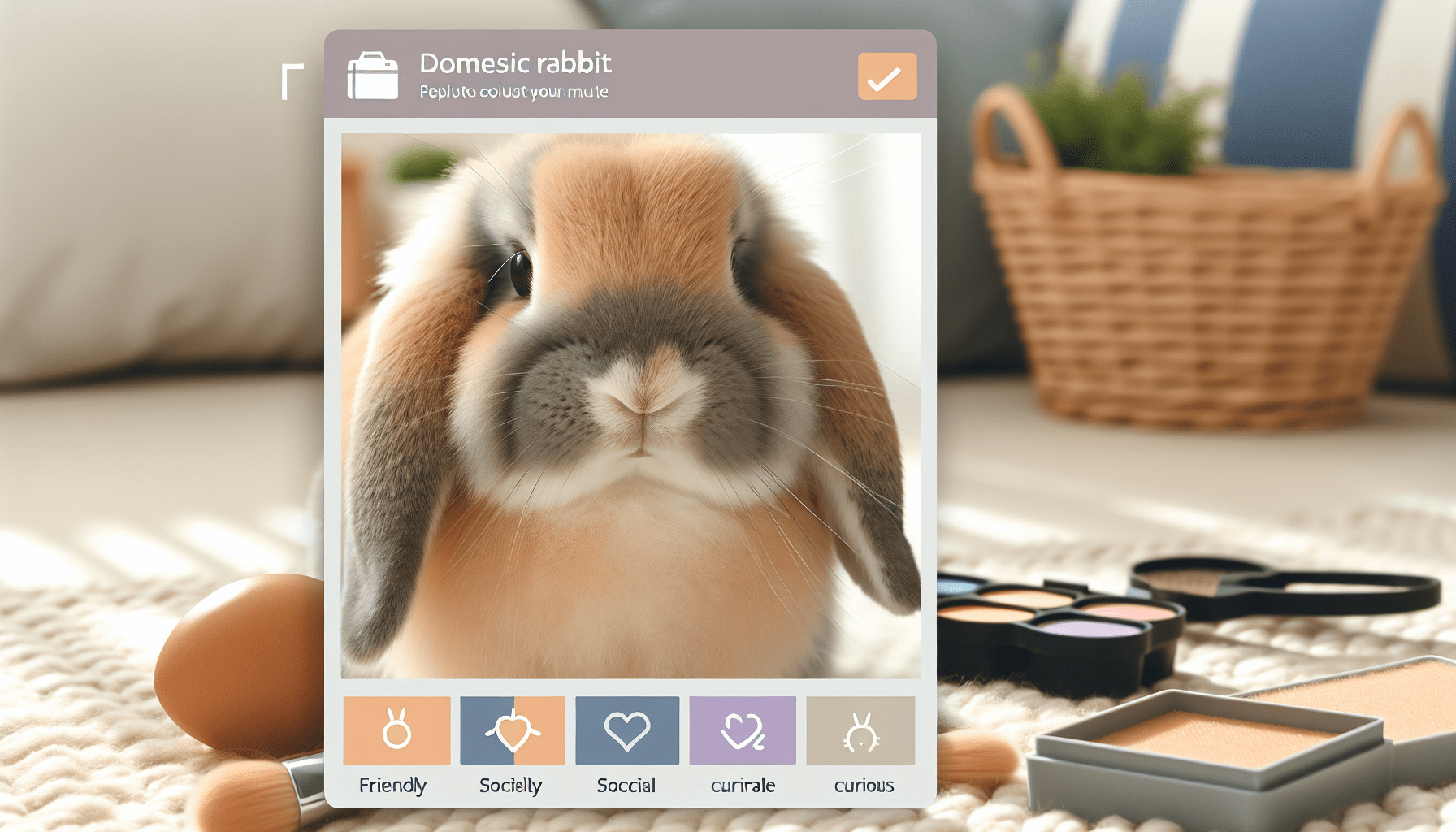If you’ve ever been curious about the world of pet rabbits, chances are you’ve come across the adorable Holland Lop and Mini Lop breeds. With their floppy ears and irresistible charm, these rabbits have captured the hearts of many. But what sets them apart? In this article, we’ll explore the key differences between the Holland Lop and Mini Lop breeds, helping you gain a better understanding of these popular pets. So whether you’re considering adding a furry friend to your family or simply have a love for bunnies, read on to discover the unique traits and characteristics that make each breed special.

Physical Characteristics
Size
Both the Holland Lop and Mini Lop rabbits are small in size, but the Holland Lop tends to be slightly larger. The Holland Lop typically weighs between 3 to 4 pounds, while the Mini Lop weighs between 2.5 to 3.5 pounds. Despite their small size, both breeds are sturdy and well-proportioned.
Body Shape
The Holland Lop and Mini Lop have similar body shapes. They both have compact and muscular bodies with short legs. Their bodies are rounded and cobby, giving them a cute and adorable appearance. This compact body shape makes them easy to handle and cuddle.
Head Shape
One of the most distinct physical features that set the Holland Lop and Mini Lop apart is their head shape. The Holland Lop has a unique feature known as a “holland fold,” where their ears fold down against the sides of their head. On the other hand, the Mini Lop has a broader and more rounded head shape with erect ears. This difference in head shape gives each breed its own charm and appeal.
Ear Length
As mentioned earlier, the Holland Lop has characteristic folded ears, while the Mini Lop has erect ears. The Holland Lop’s ears fold downwards and are relatively shorter than those of the Mini Lop. These folded ears give the Holland Lop a distinct and adorable look, making them instantly recognizable. The Mini Lop, on the other hand, has longer ears that stand upright, adding to their overall cuteness.
Fur Type
Both the Holland Lop and Mini Lop have a dense and soft coat, but they differ slightly in their fur types. The Holland Lop’s fur is usually plush and velvety, while the Mini Lop’s fur is described as medium in length and dense with a soft texture. Both breeds require regular grooming to keep their coats clean and free from mats.
Color Varieties
Both the Holland Lop and Mini Lop come in a wide range of color varieties. From solid colors to broken patterns and even tri-color combinations, there is a color and pattern to suit every rabbit lover’s taste. From classic colors like black and white to more unique shades like tortoiseshell and Siamese sable, these breeds offer a diverse and captivating range of colors.
Origin
Holland Lop
The Holland Lop breed originated in the Netherlands in the 1950s. It was created by crossing the Netherland Dwarf with the French Lop. The goal was to create a small-sized rabbit breed with lop ears. The Holland Lop quickly gained popularity in Europe and eventually made its way to the United States in the 1970s.
Mini Lop
The Mini Lop breed originated in Germany in the early 1970s. It was developed by breeding the German Lop and the small Chinchilla rabbit. The aim was to create a compact and friendly breed that could be kept as a pet. The Mini Lop gained popularity in Europe and later in the United States, where it became a recognized breed by the American Rabbit Breeders Association in 1980.
Popularity
Holland Lop
The Holland Lop is one of the most popular rabbit breeds worldwide, known for its adorable appearance and friendly temperament. Its unique folded ears and cute round face have won the hearts of many rabbit enthusiasts. The breed’s popularity can be attributed to its small size, docile nature, and suitability as a companion pet.
Mini Lop
The Mini Lop is another highly popular rabbit breed, beloved for its compact size and charming personality. Its cute and furry appearance, coupled with its friendly and affectionate nature, has made it a favorite among rabbit lovers. The Mini Lop’s popularity as a pet can also be attributed to its adaptability and ease of care.
Temperament
Holland Lop
Holland Lops have a reputation for being sweet-natured and gentle. They are known for their calm and friendly demeanor, making them great companions for people of all ages, including children. Holland Lops are usually quite sociable and enjoy human interaction, making them a popular choice for families and individuals seeking a loving and affectionate pet.
Mini Lop
The Mini Lop is known for its friendly and outgoing personality. They are often described as playful and inquisitive, always exploring their surroundings and seeking attention from their human companions. Mini Lops are generally good with children and adapt well to family life. Their sociable nature makes them a delight to have as pets.

Feeding and Care
Holland Lop
Proper nutrition is essential for the health and well-being of a Holland Lop. A balanced diet should consist of high-quality hay, fresh vegetables, and a small amount of pellets specifically formulated for rabbits. Providing fresh water at all times is crucial. Grooming should include regular brushing to prevent matting and checking their ears for cleanliness.
Mini Lop
Similarly, Mini Lops require a well-balanced diet to maintain optimal health. A mix of hay, fresh vegetables, and rabbit pellets should be provided. Fresh water should be available at all times. Regular grooming is important for Mini Lops, including brushing their fur to remove loose hair and checking their ears for any signs of dirt or infection.
Health Concerns
Holland Lop
Holland Lops, like all rabbit breeds, are susceptible to certain health issues. Some common health concerns include dental problems, such as overgrown teeth, GI stasis, which is a slowed or stopped digestive system, and ear infections due to their folded ear structure. Regular veterinary check-ups and a proper diet can help prevent and manage these health issues.
Mini Lop
Mini Lops, too, have their share of potential health concerns. Dental problems, obesity, and ear infections are among the common health issues seen in this breed. Routine veterinary care and a well-balanced diet can help minimize the risk of these health problems and ensure the overall well-being of the rabbit.
Ideal Living Conditions
Holland Lop
Holland Lops are adaptable and can be kept both indoors and outdoors, but they thrive best as indoor pets. They prefer a quiet and calm environment away from excessive noise or temperature extremes. A suitable living space should provide enough room to hop around and exercise, with a comfortable resting area and access to fresh food and water.
Mini Lop
Like the Holland Lop, Mini Lops prefer to be kept indoors in a quiet and secure environment. They are sensitive to extreme temperatures, so it’s important to keep their living space at a comfortable temperature. Mini Lops require room to roam and play, as well as a cozy area to rest and retreat to when needed.
Suitability as Pets
Holland Lop
Holland Lops make excellent pets and are well-suited for families, individuals, and even first-time rabbit owners. Their friendly and sociable nature, combined with their small size and adorable appearance, make them a popular choice for those seeking a loving and affectionate companion. They are generally good with children and can adapt well to indoor living.
Mini Lop
Mini Lops are also well-suited as pets, particularly for families and individuals looking for a playful and sociable companion. Their outgoing personality and love for human interaction make them great family pets. Mini Lops are generally good with children but still require supervision and gentle handling to ensure their safety and well-being.
Behavioral Differences
Holland Lop
Holland Lops are known for their calm and gentle temperament. They are generally less active than Mini Lops and tend to be more laid-back and relaxed. This makes them ideal for individuals seeking a more low-key and calm pet rabbit. Holland Lops enjoy human interaction and can form deep bonds with their owners.
Mini Lop
Compared to their Holland Lop counterparts, Mini Lops are often more energetic and playful. They tend to be curious and enjoy exploring their surroundings. Mini Lops thrive on human attention and interaction, often seeking out their owners for playtime and affection. Their lively nature can provide entertainment and joy to their owners.
Price Differences
Holland Lop
The cost of a Holland Lop rabbit can vary depending on factors such as the rabbit’s pedigree, quality, and the breeder. On average, a Holland Lop can range in price from $50 to $150. Show-quality or rare color variety Holland Lops can be more expensive, reaching prices of $200 or more. It’s important to research and find a reputable breeder when considering purchasing a Holland Lop.
Mini Lop
Similarly, the price of a Mini Lop rabbit can vary based on certain factors such as lineage, quality, and the breeder’s reputation. On average, a Mini Lop can cost between $40 to $100. Show-quality or rare-colored Mini Lops can be priced higher, ranging from $100 to $200 or more. When buying a Mini Lop, it’s essential to choose a reputable breeder to ensure a healthy and well-cared-for rabbit.
In conclusion, while both the Holland Lop and Mini Lop rabbits share similarities in size and body shape, they differ in head shape, ear length, and fur type. Both breeds have their origins in Europe and have gained popularity as delightful companion pets. Holland Lops are known for their gentle and calm temperament, while Mini Lops are more energetic and playful. With proper care, both breeds can bring joy and companionship to their owners. When considering a rabbit as a pet, it’s important to understand the specific needs of each breed and choose the one that best fits your lifestyle and preferences.
